In 1971,
the Uniform Monday Holiday Act established three-day weekends for all major
holidays and annual commemorations. In many states, Presidents Day became
associated with one of the weekends. Before 1971, my hometown in Indiana
celebrated Lincoln’s Birthday on the 12th of February and Washington’s Birthday
on the 22nd of the same month. (The 22nd is an adjustment made when the country
switched from the Julian calendar to the Gregorian calendar, which is explained
on several websites.) When I was in grade school, we took time to honor Lincoln
on his day and to honor Washington on his.
 |
|
A
Pencil Sketch of President Abraham Lincoln
That
I Drew in 1965—Similar to My Pastel Portrait
That
Won the School Art Contest
|
Every year,
the art teacher invited the junior high and high school students to make
portraits of Lincoln that were judged, with the announcement of the winner
during the Republican Lincoln Day Dinner in the gymnasium. Several of the older
students were blessed with artistic talent and skill, and their portraits of
Lincoln were exceptional. The best of the best were displayed in the cafeteria,
and I admired them. When I was in seventh grade, I was determined to create a
portrait that could compete with those of the high school students. I chose
pastel chalk as my medium, and I spent hours and hours meticulously forming
Lincoln’s face. I refused to permit myself to hurry (my natural tendency), and
I devoted many evenings to the slow development of my art. I compared several
images of Lincoln that I had collected at school. My portrait was not a direct
copy of any one of them but a compilation of features I observed in several of
them.
As my
mother spoke glowingly to me about my finished work, I developed confidence
that I could enter my portrait of Lincoln in the contest. Even though my mother
had reassured me, I was shocked through and through when the art teacher
confided in me that my art had won the competition!
I wore a
suit and tie to the dinner, and, blushing with joy, I stood before the
applauding audience while my portrait was announced as the contest winner.
I often
think back to that occasion and also to the days when my classmates and I
worked with crayons to color purple-dittoed American flags while listening to
our teachers as they read to us about Washington and Lincoln. Such activities
instilled in me a respect for the dignity of the President of the United States
and a patriotism that I feel today. Somehow, I can hardly help questioning
whether the abandonment of Lincoln’s Birthday and Washington’s Birthday in
favor of Presidents Day in 1971 may have caused important values to have become
lost. I wonder if February comes and goes without stirring the hearts of
children the way my heart was stirred when, so many years ago, the red, white,
and blue month of Lincoln and Washington rolled around.




